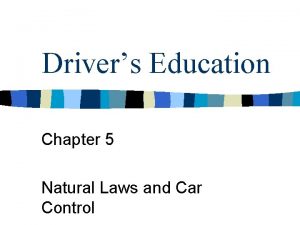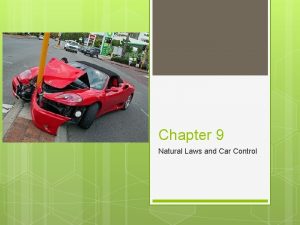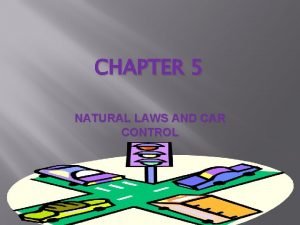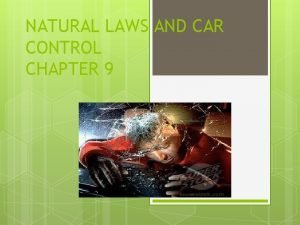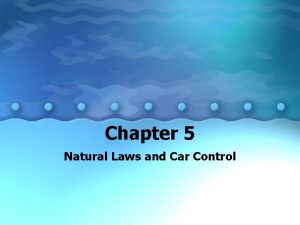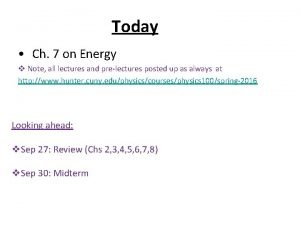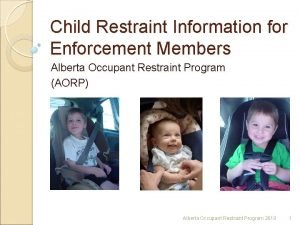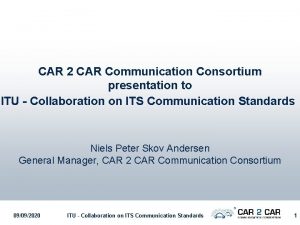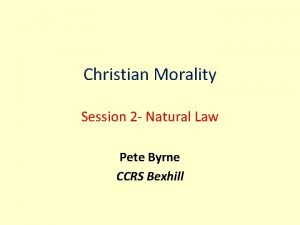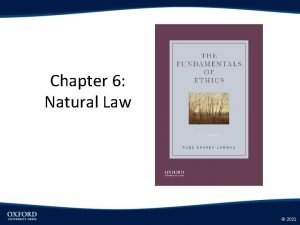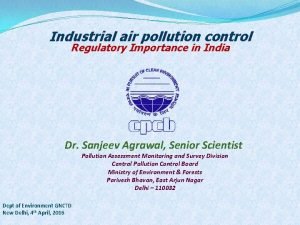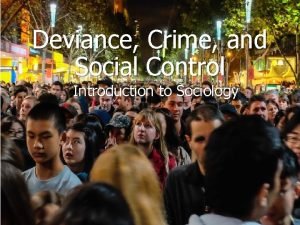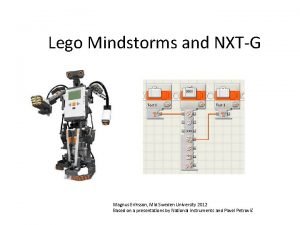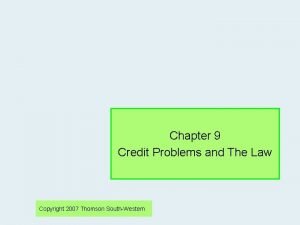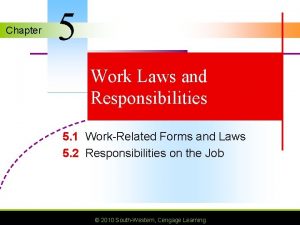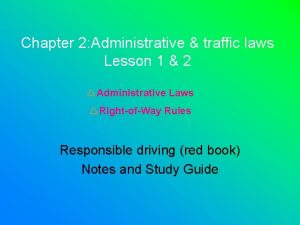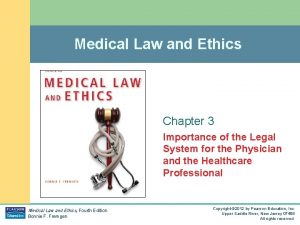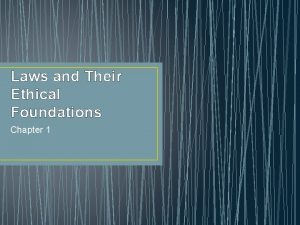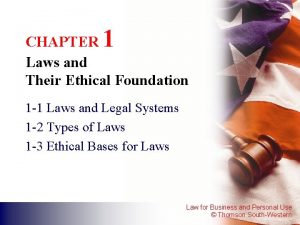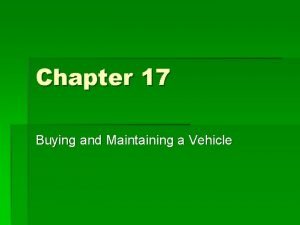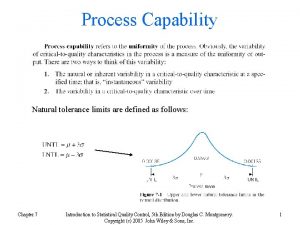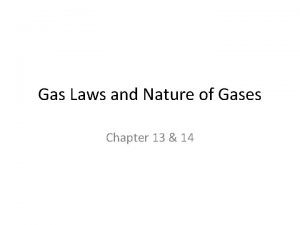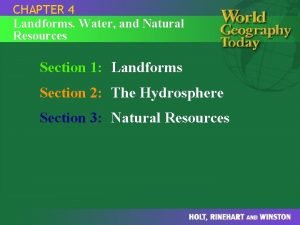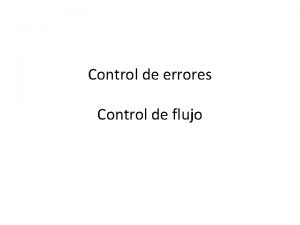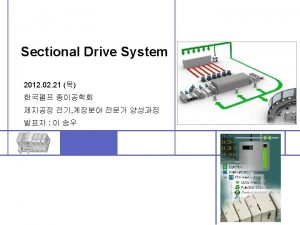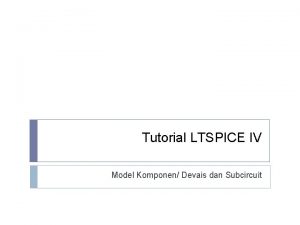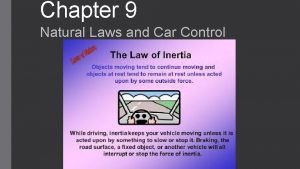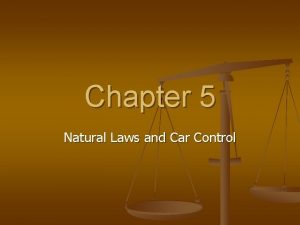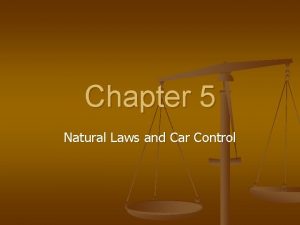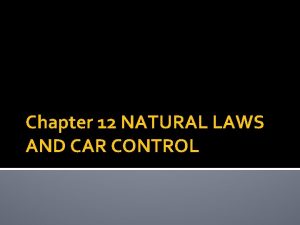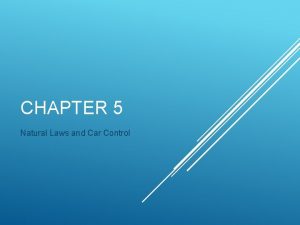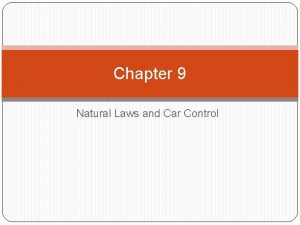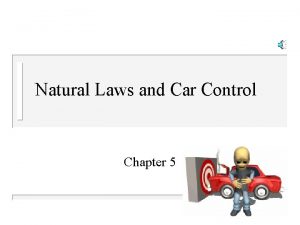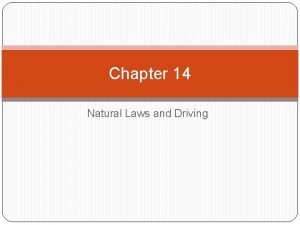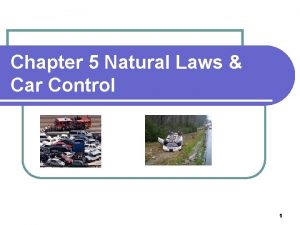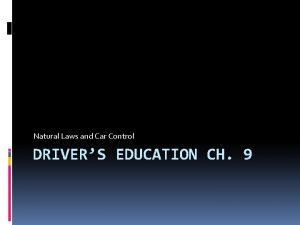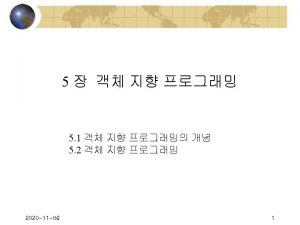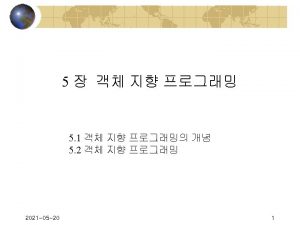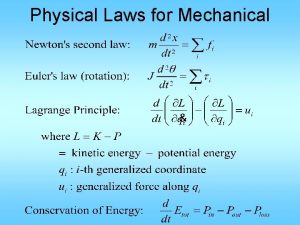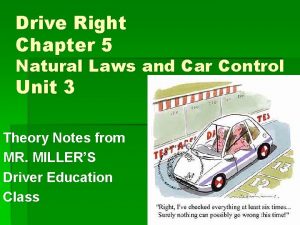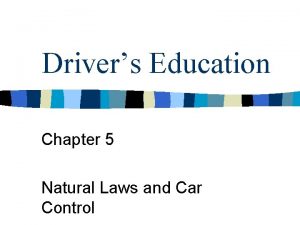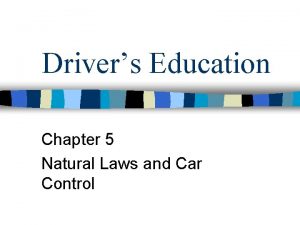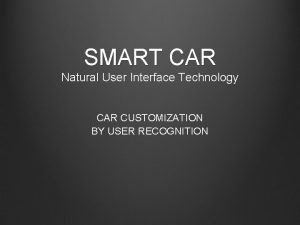Chapter 5 Natural Laws and Car Control 5

















































- Slides: 49

Chapter 5 Natural Laws and Car Control

5. 1 Gravity and Energy of Motion

_________ Is the force that pulls all things to Earth.

Driving Up Hills n n You will ______speed unless you use extra power To hold speed n n You must ______the vehicle’s power to overcome the pulling force of gravity Easier to ______!

Driving Down Hills n Gravity will ______your speed while going down hill. n Will take you longer to ______! n Always ______while down a hill! going

______of ______ n Is the point around which an object’s weight is ______distributed. n Lower the center of gravity – the ______stable the object becomes. n SUVs very ______especially when you lift them. *Car carriers!

______of ______ n n n The ______energy or the energy an object has because it is moving. The faster your vehicle moves, the ______energy of motion it has. Energy of motion is also affected by the ______of the moving object.

Energy of Motion and Stopping Distance n n Go to page 93. When a truck weighs twice as much; it needs about ______the distance to STOP!

5. 2 Friction & Traction

______ n Is the force that keeps each tire from ______on the road. n You can feel the same force by rubbing your hands together.

______ n n Friction or gripping power between the ______and the roadway surface. Traction makes it possible for your vehicle to ______the road so you can change speed and direction.

TIRES!!!! n n Tires make a huge difference in the way your vehicle performs. Driving with low pressure in your tires can be the difference between avoiding a collision or hitting something. n We will discuss this very soon!

Tread and Traction n ______- outer grooved surface of a tire that grips the road. n Tread allows the tire to cut through ______and grip the road.

Bald tires n ______ grip the road n More likely to have a blowout. n ______ n Is where all the air escapes a tire at once.

Inflation and traction n See page 95 Always check the owner’s manual to find out the best air pressure range to keep your tires at! Check regularly! Cold weather – pressure ______ n Hot weather – pressure ______ n

Underinflation n Only the ______of the tires will grip the ground. Outside part of tires will wear first which equally short life of the tires. In emergencies it will not perform properly.

Overinflation n n Only the ______of the tire will grip the road. The center of the tire will wear more quickly than a normal tire.

Reduced Traction n Vehicle’s condition n ____________

When are the road most slippery? _______________________ __________

Curves n n n Energy of motion and traction will work on your vehicle as you go around a curve. The energy of motion will try to make your vehicle go ______in a curve. ______the speed = more it will tend to go straight.

Speed and Curves n n You cant control the ______but you can control your ______. Reduce your chances of skidding by ______your speed before entering a curve.

Sharpness of Curves n n The sharper a curve, the more traction your vehicle needs to grip the road. Sharper the curve = ______ your speed

Banked Curves n n A curve that is ______on the outside than it is on the inside. Helps to overcome your vehicle's tendency to move to the outside of the curve.

5. 3 Stopping Distance

__________ Distance The distance your car travels while you make a stop.

______ Time n n The ______ it takes to identify, predict, and decide to slow for a hazard. Perception time will vary depending on: n ______ n The ______ of hazard

Perception _____ n The ______ your vehicle travels during perception time. n Depending on the driving situation this may change.

______ Time n The length of time you take to execute your action. n Average reaction time is ______ of a second.

______ Distance n The distance your vehicle travels while you react.

______ Distance n The distance you vehicle travels from the time you ______ the brake until your vehicle ______. * If you accelerate from 20 mph to 40 mph, your braking distance will be about ______ times longer.

How do you estimate stopping distance? n n n Pick a fixed object or checkpoint ahead where you think you can stop. Count _____ seconds. Check your position. If you reached it, then you can assume that you could have stopped there under ideal conditions. *If you were traveling 65 mph, it would take about 300 ft to stop (length of a football field. )

Factors that Affect Braking Distance n n n Speed – higher speed ______ the braking distance Vehicle Condition – vehicles with worn shocks, ______, and brakes need longer time Roadway surface – rain, ______, ice, dirt, gravel, & ______ reduce traction

n n Driver Ability – if you are distracted or impaired, it will take you longer to stop your vehicle. Antilock Braking System – allows you to better control your stopping distance while turning Hills – braking ______ when driving downhill Loads – ______loads increase your braking distance

5. 4 Controlling Force of Impact

Force of Impact n The force with which a ___________________________ n Three factors that determine how hard something will hit another object: n ________________

Speed n n n Is the ______ factor in determining how hard a vehicle will hit another object. Any reduction in speed will greatly ______ the damage inflicted. Always try to ______ speed in an emergency.

Weight n n The heavier a vehicle, the ______ damage it will cause in a collision. A vehicle weighing twice as much as another vehicle will hit a solid object ______ as hard.

Distance between impact & stopping n n The _______ a vehicle covers between the instant it hits an object and the moment it comes to a _____ can vary greatly. Sand barrels slow your vehicle as it hits a guardrail.

How many collisions occur when you are in a collision? n n n 1 st – The _______ hits the object and stops. 2 nd – The _______ either hit the inside of the vehicle or their restraints devices. 3 rd – Occupants may suffer internal collisions as their organs _______ their bodies.

Passive Restraints Devices n Works n Ex. ______________

Active Restraint Devices n n Is a device that you have to _______. Ex. _______

How to wear safety belts 1. 2. 3. Adjust your seat to a comfortable upright position. Buckle your seatbelt making sure lap part is low and snug across your hips. Adjust shoulder part. Never put it behind your body!

Air Bags n Is balloon-type device that automatically inflates to protect you. n They deploy at speeds over _______ mph. n Are designed to work with ______. n Keep hands between 9 and 3 o’clock and 8 and 4 o’clock to prevent serious hand, arm, head, and eye injury.

Airbags continued… n n Make sure you sit at least _______ inches away from the steering wheel. Children in child seats and young people up to the age of _______ must sit in the back seat.

Air bag Improvements n n Sensors can measure weight, seat position, and severity of crash. n Deploys in 2 stages appropriate for speed and intensity Airbag switches give vehicle owners a choice about using an airbag.

Other Protection Devices n Automatic Safety Belts n n Front and rear crush areas n n Make sure you buckle the lap belt Designed to _______ on impact like an accordion Energy absorbing bumpers n Absorb low levels of impact up to _____ mph without damage

n Side door beams n n _______ windshield n n Steal beams built into the side door. Two pieces of glass with a thin layer of plastic in the middle help avoid flying glass. Energy-absorbing steering wheel n Designed to _______ when hit.

n _______ dash n n _______ seats n n Can reduce injury in all crashes All states require them. Must be used in the back seat. Head restraints n Padded head rests on top of seat protect against _______.

GOOD LUCK on Tuesday or Thursday
 Force that keeps each tire from sliding on the road
Force that keeps each tire from sliding on the road Natural laws and car control quiz
Natural laws and car control quiz Chapter 5 natural laws and car control
Chapter 5 natural laws and car control Chapter 9 natural laws and car control
Chapter 9 natural laws and car control Chapter 5 natural laws and car control
Chapter 5 natural laws and car control Qq moves
Qq moves A 1000 kg car and a 2000 kg car is hoisted the same height
A 1000 kg car and a 2000 kg car is hoisted the same height Useless laws weaken the necessary laws
Useless laws weaken the necessary laws Alberta occupant restraint program
Alberta occupant restraint program Car 2 car communication consortium
Car 2 car communication consortium Human nature and natural law
Human nature and natural law Natural law theorist
Natural law theorist Aristotle virtue ethics
Aristotle virtue ethics Natural capital
Natural capital Slogan on air pollution
Slogan on air pollution What is the labelling theory
What is the labelling theory Lego remote control car
Lego remote control car The cruise-control function on georgina's car
The cruise-control function on georgina's car Natural hazards vs natural disasters
Natural hazards vs natural disasters Chapter 9 credit problems and laws
Chapter 9 credit problems and laws Chapter 5 work laws and responsibilities
Chapter 5 work laws and responsibilities Chapter 2 administrative and traffic laws
Chapter 2 administrative and traffic laws Administrative and traffic laws
Administrative and traffic laws Chapter 17 records
Chapter 17 records Law versus ethics chapter 3
Law versus ethics chapter 3 Chapter 1 laws and their ethical foundation
Chapter 1 laws and their ethical foundation Chapter 2 administrative and traffic laws
Chapter 2 administrative and traffic laws Chapter 1 laws and their ethical foundation
Chapter 1 laws and their ethical foundation Chapter 17 owning and maintaining a car
Chapter 17 owning and maintaining a car Distinguish between process control and product control
Distinguish between process control and product control Lac operon positive control
Lac operon positive control Error control and flow control
Error control and flow control Natural tolerance
Natural tolerance Natural access control examples
Natural access control examples Boyle's law examples
Boyle's law examples The great gatsby chapter 3
The great gatsby chapter 3 Natural resources from landforms
Natural resources from landforms Translational research institute on pain in later life
Translational research institute on pain in later life Fluid mechanics
Fluid mechanics Stock control e flow control
Stock control e flow control Control volume vs control surface
Control volume vs control surface Positive control vs negative control
Positive control vs negative control Data link control
Data link control Control de flujo y control de errores
Control de flujo y control de errores Negative control vs positive control examples
Negative control vs positive control examples Scalar control vs vector control
Scalar control vs vector control Salin teks di foto
Salin teks di foto Chapter 7 deviance crime and social control
Chapter 7 deviance crime and social control Deviants chapter 8
Deviants chapter 8 Chapter 26 infectious disease prevention and control
Chapter 26 infectious disease prevention and control
